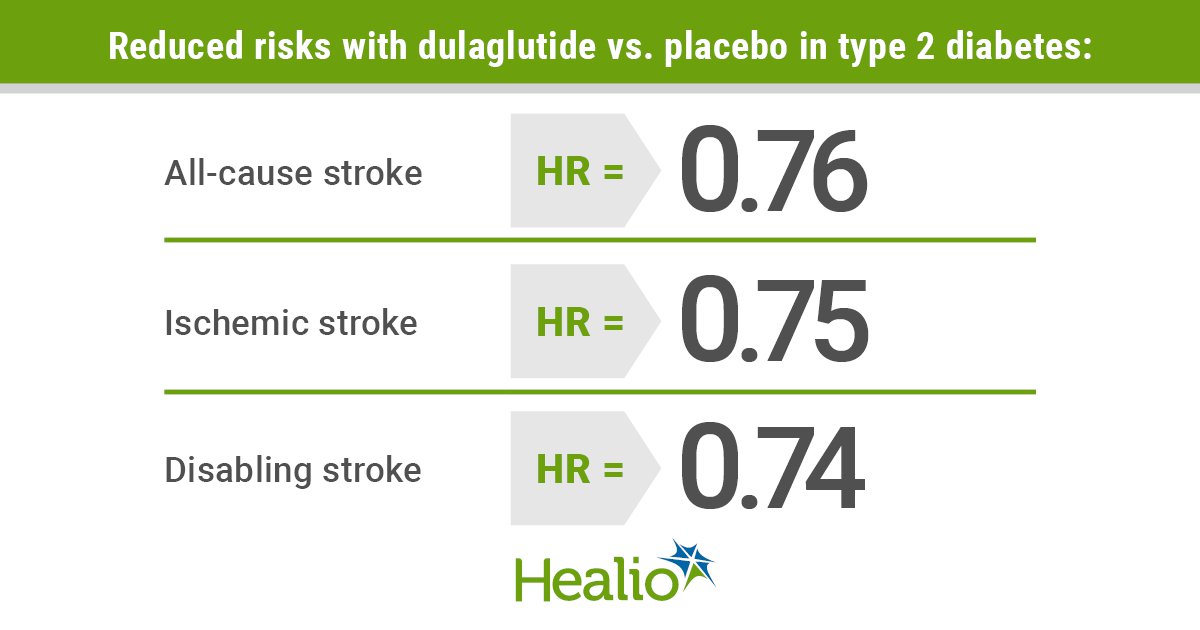REWIND: Dulaglutide reduces stroke risk in type 2 diabetes

Middle-aged and older adults with type 2 diabetes and additional cardiovascular risk factors assigned the GLP-1 receptor agonist dulaglutide were 24% less likely to experience stroke during 5 years of follow-up compared with those assigned placebo, according to findings from a new analysis of the REWIND study.
As Healio previously reported, findings from REWIND — the first major CV outcomes trial for a diabetes therapy to include a large primary prevention population — demonstrated that dulaglutide (Trulicity, Eli Lilly) reduced the composite risk for nonfatal myocardial infarction, nonfatal stroke and CV death by 12% compared with placebo, as well as renal benefits in participants assigned the drug.
“In this exploratory analysis, dulaglutide reduced the incidence of stroke, and particularly ischemic stroke,” Hertzel C. Gerstein, MD, MSc, FRCPC, professor and population health institute chair in diabetes research at McMaster University and Hamilton Health Sciences in Ontario, Canada, told Healio. “Dulaglutide and other GLP-1 receptor agonists may be particularly beneficial for people at higher risk for stroke. Dedicated studies of the effect of dulaglutide and other GLP-1 receptor agonists on stroke and brain health in general should clearly be done.”
Gerstein and colleagues analyzed data from 9,901 adults aged at least 50 years with type 2 diabetes (HbA1c, 9.5%) and a history of a previous CV event or CV risk factors, recruited from 371 sites in 24 countries from August 2011 to August 2013 (mean age, 66 years; 46.3% women; median diabetes duration, 9.5 years; median HbA1c, 7.2%). Participants were taking stable doses of up to two oral glucose-lowering drugs, with or without basal insulin therapy. Within the cohort, only 31.4% of participants had prior CVD. Researchers randomly assigned patients to once-weekly dulaglutide (n = 4,949) or placebo (n = 4,952). Primary endpoint was first occurrence of any component of the composite CV outcome of nonfatal MI, nonfatal stroke and CV death. Researchers categorized strokes as fatal or nonfatal, and as either ischemic, hemorrhagic or undetermined. Stroke severity was assessed using the modified Rankin scale.

During a median follow-up of 5.4 years, 158 participants in the dulaglutide group and 205 participants in the placebo group experienced a stroke (3.2% vs. 4.1%), for an HR of 0.76 (95% CI, 0.62-0.94).
In analyses stratified by stroke type, researchers found that dulaglutide reduced ischemic stroke (HR = 0.75; 95% CI, 0.59-0.94), but had no effect on hemorrhagic stroke. Dulaglutide also reduced composite risk for nonfatal stroke or all-cause death (HR = 0.88; 95% CI, 0.79-0.98) and disabling stroke (HR = 0.74; 95% CI, 0.56-0.99).
The degree of disability after stroke did not differ by treatment group.
“Given the frequency of stroke in people with diabetes, the severity of its associated morbidity, and the paucity of preventive therapies, the findings of this study suggest that GLP-1 receptor agonists should be considered when developing future stroke prevention guidelines for people with diabetes,” the researchers wrote. “Furthermore, our study strongly supports the need for further research on the effect of these drugs on stroke.” – by Regina Schaffer
For more information:
Hertzel C. Gerstein, MD, MSc, FRCPC, can be reached at McMaster University, Department of Medicine, 1280 Main St. West, HSC 3V38-50, Hamilton, Ontario, L8S 4K1, Canada; email: gerstein@mcmaster.ca.
Disclosures: Eli Lilly funded the REWIND study. Gerstein reports he has received consultant fees, grants and honoraria from Abbott, AstraZeneca, Boehringer Ingelheim, Cirius, Eli Lilly, Janssen, Kowa, Merck, Novo Nordisk and Sanofi. Please see the study for all other authors’ relevant financial disclosures.
